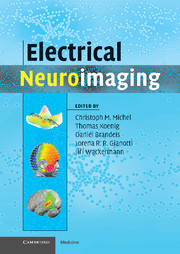Book contents
- Frontmatter
- Contents
- List of contributors
- Preface
- 1 From neuronal activity to scalp potential fields
- 2 Scalp field maps and their characterization
- 3 Imaging the electric neuronal generators of EEG/MEG
- 4 Data acquisition and pre-processing standards for electrical neuroimaging
- 5 Overview of analytical approaches
- 6 Electrical neuroimaging in the time domain
- 7 Multichannel frequency and time-frequency analysis
- 8 Statistical analysis of multichannel scalp field data
- 9 State space representation and global descriptors of brain electrical activity
- 10 Integration of electrical neuroimaging with other functional imaging methods
- Index
- References
6 - Electrical neuroimaging in the time domain
Published online by Cambridge University Press: 15 December 2009
- Frontmatter
- Contents
- List of contributors
- Preface
- 1 From neuronal activity to scalp potential fields
- 2 Scalp field maps and their characterization
- 3 Imaging the electric neuronal generators of EEG/MEG
- 4 Data acquisition and pre-processing standards for electrical neuroimaging
- 5 Overview of analytical approaches
- 6 Electrical neuroimaging in the time domain
- 7 Multichannel frequency and time-frequency analysis
- 8 Statistical analysis of multichannel scalp field data
- 9 State space representation and global descriptors of brain electrical activity
- 10 Integration of electrical neuroimaging with other functional imaging methods
- Index
- References
Summary
Spatial analysis of the spontaneous EEG
Resting state and neurocognitive networks
A publication entitled “A default mode of brain function” initiated a new way of looking at functional imaging data. In this PET study the authors discussed the often-observed consistent decrease of brain activation in a variety of tasks as compared with the baseline. They suggested that this deactivation is due to a task-induced suspension of a default mode of brain function that is active during rest, i.e. that there exists intrinsic well-organized brain activity during rest in several distinct brain regions. This suggestion led to a large number of imaging studies on the resting state of the brain and to the conclusion that the study of this intrinsic activity is crucial for understanding how the brain works.
The fact that the brain is active during rest has been well known from a variety of EEG recordings for a very long time. Different states of the brain in the sleep–wake continuum are characterized by typical patterns of spontaneous oscillations in different frequency ranges and in different brain regions. Best studied are the evolving states during the different sleep stages, but characteristic EEG oscillation patterns have also been well described during awake periods (see Chapter 1 for details). A highly recommended comprehensive review on the brain's default state defined by oscillatory electrical brain activities is provided in the recent book by György Buzsaki, showing how these states can be measured by electrophysiological procedures at the global brain level as well as at the local cellular level.
- Type
- Chapter
- Information
- Electrical Neuroimaging , pp. 111 - 144Publisher: Cambridge University PressPrint publication year: 2009
References
- 28
- Cited by



